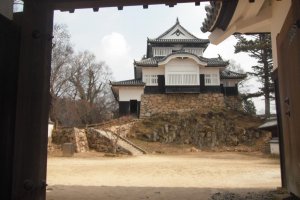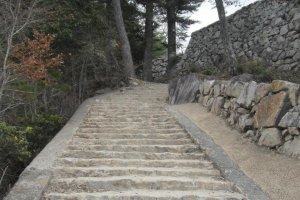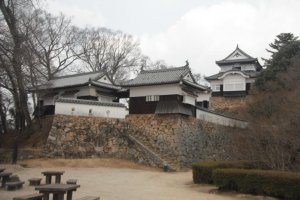What comes to mind when you hear the words “Japanese Castle?” Himeji-jo? Matsumoto? Kumamoto? These buildings are breathtakingly amazing, but my favorite is Bitchū Matsuyama. Why? With only a two-story tower and several turrets some say it's the shortest Japanese castle, but with its amazing location and well-balanced layout, this striking black-and-white castle is amazing and will take you to another time, far away from the 21st century.
At an elevation of 430 m (the highest castle in all of Japan), Bitchū Matsuyama Castle spreads across the top of Gagyuyama, and is surrounded by forests, designated for having a natural botanic significance for its more than 1,000 different plant species.
The ruins of the castle, donjon (fortified main tower of a castle), turrets and sections of the wall have been designated as important cultural properties since 1950. It is one of 12 castles in Japan considered to be original, meaning that either the keep or main tower was built prior to the close of the feudal era.
When I walked along the path leading away from the car park I felt that I was being taken back in time. Winding up higher and higher I caught glimpses through the forests of a sea of mist, which forms in the area because of the geology. It was rugged, windy and wild, with a certain sense of harshness and loneliness.
I first came across ruined areas, perhaps dating back to times when it was a castle town. I stood on a ruined wall jutting out into the forest. What would it have been like to live there then?
When I finally gazed upon the stone walls I was in awe at the work and effort. The castle is laid out beautifully across the hilltop, with a number of different levels. It was very quiet the day in early March when I went. I had no need to rush, no crowds and leisurely strolled through the buildings and grounds. “Who had lived here?” I wondered as I quietly walked across the timber floors. Who had prayed at the same shrine that I did?
This castle and its surroundings are very well kept, with no signs of current times or encroachment by modern buildings. Much of the appeal for me is that in most areas you can only see the mountains, forests, misty clouds and sky. It is surrounded by a deep sense of peace and tranquility. I listened to the birds and the wind through the trees.
GETTING THERE
I have a car and drove to this wonderous place, but if you don’t have one you can easily get here. The town of Takahashi is in Okayama prefecture, about 50 km north of Okayama City on the JR Hakubi Line. Trains go from Okayama to Takahashi from 5:28 until 23:25, with at least one every hour. You can get the local train, which takes about 58 minutes and costs ¥820, or the limited express, which takes 35 minutes and costs ¥2,260. The castle is 5 km from Bitchū Takahashi Station, and the final 900 m is a steep uphill walk. You can get a taxi from the station to the castle car park, and they were frequently coming and going on the day I was there – sorry, don’t know the cost!
Bitchū Matsuyama Castle and Takahashi are not on any major tourist routes but it is well worth a visit. You can continue through this beautiful and varying mountainous area by train from Okayama through to Niimi city before crossing over to Tottori prefecture or onto Matsue city in Shimane prefecture - I drove in the reverse direction and was amazed by the stunning scenery!
HISTORY
Here is a brief history that I discovered about Bitchū Matsuyama Castle when I researched it for my trip. It was in use between 1240 and 1874 and has been associated with a number of clans over its 712 year life: Mori, Nibori, Ikeda, Mizunoya, Ando, Ishikawa, and Itakura.
Its story begins in 1240 when a fort was built on nearby Omatsuyama by Shigenobu Akiba. Around 1331 the fort was enlarged to take in Komatsuyama and the castle was built on the present site by an officer of the local area, Kurozaemon Muneyasu Takahashi.
Later, Motochikura Mimura became the region’s feudal lord and the castle was enlarged again. With the help of the Mori clan, he conquered the Bitchū area, but around 1575 was killed by the Mori clan for betraying them.
In 1600 the Nibori clan became the rulers of the area. Following the Battle of Sekigahara, Masatsugu Kobori and his son Masakazu came as officers of the Tokugawa Shogunate, and began repair works on the castle, in an effort to make Matsuyama a castle town. The following lord, Katsutaka Mizunoya, rebuilt the donjon, turrets and other gates, plus Onegoya House to the southern side, from which public affairs were administered.
Katsuzumi Itakawa became lord in 1744, and over the following 126 years there were 8 successive Itakawa lords until 1868, when, at the onset of the Meiji era, the castle surrendered to Imperial forces following the order to abolish castles.
Bitchū Matsuyama castle was abandoned and left to ruins in 1873/4 but in 1929 a group of local citizens formed to preserve and repair the turrets. Later, Takahashi city repaired the donjon and walls. In 1957 the government began restoring the castle to its original state and this work was completed in 1960.
































